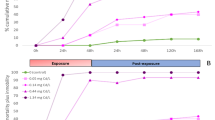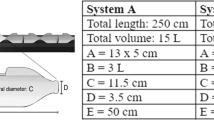Abstract
The effect of heavy metals on species survival is well documented; however, sublethal effects on behaviour and physiology are receiving growing attention. Measurements of changes in activity and respiration are more sensitive to pollutants, and therefore a better early indicator of potentially harmful ecological impacts. We assessed the effect of acute exposure (48 h) to two heavy metals at concentrations below those allowable in municipal drinking water (Zn: 1,100 μg/l; Cd: 3 μg/l) on locomotion and respiration using the freshwater snail, Lymnaea stagnalis. In addition we used a novel assessment method, testing the ability of the snail to form memory in the presence of heavy metals in both intact snails, and also snails that had the osphradial nerve severed which connects a chemosensory organ, the osphradium, to the central nervous system. Aerial respiration and locomotion remained unchanged by acute exposure to heavy metals. There was also no effect on memory formation of these metals when administered alone. However, when snails were exposed to these metals in combination memory formation was blocked. Severing the osphradial nerve prevented the memory blocking effect of Zn and Cd, indicating that the snails are sensing these metals in their environment via the osphradium and responding to them as a stressor. Therefore, assessing the ability of this species to form memory is a more sensitive measure of heavy metal pollution than measures of activity, and indicates that the snails’ ability to demonstrate behavioural plasticity may be compromised by the presence of these pollutants.




Similar content being viewed by others
Abbreviations
- LTM:
-
Long-term memory
- CNS:
-
Central nervous system
- TS1:
-
First training session
- TS2:
-
Second training session
- MT:
-
Memory test
References
Amiard-Triquet C (2009) Behavioral disturbances: the missing link between sub-organismal and supra-organismal responses to stress? prospects based on aquatic research. Hum Ecol Risk Assess 15(1):87–110. doi:10.1080/10807030802615543
Barry MJ (2011) Effects of copper, zinc and dragonfly kairomone on growth rate and induced morphology of Bufo arabicus tadpoles. Ecotoxicol Environ Saf 74(4):918–923. doi:10.1016/j.ecoenv.2010.12.014
Benjamin PR, Kemenes G (2008) Behavioral and circuit analysis of learning and memory in mollusks. In: Byrne JH (ed) Learning and memory: a comprehensive reference. Academic Press, Oxford, pp 587–604
Bernot RJ, Turner AM (2001) Predator identity and trait-mediated indirect effects in a littoral food web. Oecologia 129(1):139–146
Boyd RS (2010) Heavy metal pollutants and chemical ecology: exploring new frontiers. J Chem Ecol 36(1):46–58. doi:10.1007/s10886-009-9730-5
Brönmark C (1989) Interactions between epiphytes, macrophytes and fresh-water snails—a review. J Molluscan Stud 55:299–311. doi:10.1093/mollus/55.2.299
Brönmark C (1994) Effects of tench and perch on interactions in a fresh-water, benthic food-chain. Ecology 75(6):1818–1828. doi:10.2307/1939640
Coeurdassier M, De Vaufleury A, Badot PM (2003) Bioconcentration of cadmium and toxic effects on life-history traits of pond snails (Lymnaea palustris and Lymnaea stagnalis) in laboratory bioassays. Arch Environ Contam Toxicol 45(1):102–109. doi:10.1007/s00244-002-0152-4
Coeurdassier M, de Vaufleury A, Crini N, Scheifler R, Badot PM (2005) Assessment of whole effluent toxicity on aquatic snails: bioaccumulation of Cr, Zn, and Fe, and individual effects in bioassays. Environ Toxicol Chem 24(1):198–204. doi:10.1897/03-505.1
Dalesman S, Karnik V, Lukowiak K (2011) Sensory mediation of memory blocking stressors in the pond snail, Lymnaea stagnalis. J Exp Biol 214:2528–2533. doi:10.1242/jeb.058024
Dalesman S, Lukowiak K (2010) Effect of acute exposure to low environmental calcium alters respiration and locomotion of Lymnaea stagnalis (L.). J Exp Biol 213:1471–1476. doi:10.1242/jeb.040493
Dalesman S, Rundle SD (2010) Cohabitation enhances the avoidance response to heterospecific alarm cues in a freshwater snail. Anim Behav 79:173–177. doi:10.1016/j.anbehav.2009.10.024
Dalesman S, Rundle SD, Coleman RA, Cotton PA (2006) Cue association and antipredator behaviour in a pulmonate snail, Lymnaea stagnalis. Anim Behav 71:789–797. doi:10.1016/j.anbehav.2005.05.028
Dalesman S, Rundle SD, Cotton PA (2009) Developmental plasticity compensates for selected low levels of behavioural avoidance in a freshwater snail. Anim Behav 78(4):987–991. doi:10.1016/j.anbehav.2009.07.018
Das S, Khangarot BS (2010) Bioaccumulation and toxic effects of cadmium on feeding and growth of an Indian pond snail Lymnaea luteola L. under laboratory conditions. J Hazard Mater 182(1–3):763–770. doi:10.1016/j.jhazmat.2010.06.100
Das S, Khangarot BS (2011) Bioaccumulation of copper and toxic effects on feeding, growth, fecundity and development of pond snail Lymnaea luteola L. J Hazard Mater 185(1):295–305. doi:10.1016/j.jhazmat.2010.09.033
de Bisthoven LJ, Gerhardt A, Guhr K, Soares A (2006) Behavioral changes and acute toxicity to the freshwater shrimp Atyaephyra desmaresti millet (Decapoda: Natantia) from exposure to acid mine drainage. Ecotoxicology 15(2):215–227. doi:10.1007/s10646-005-0052-2
Fleeger JW, Carman KR, Nisbet RM (2003) Indirect effects of contaminants in aquatic ecosystems. Sci Total Environ 317(1–3):207–233. doi:10.1016/s0048-9697(03)00141-4
Gerhardt A (2007) Aquatic behavioral ecotoxicology—prospects and limitations. Hum Ecol Risk Assess 13(3):481–491. doi:10.1080/10807030701340839
Gerhardt A (2009) Screening the toxicity of Ni, Cd, Cu, ivermectin, and imidacloprid in a short-term automated behavioral toxicity test with Tubifex tubifex (Muller 1774) (Oligochaeta). Hum Ecol Risk Assess 15(1):27–40. doi:10.1080/10807030802614983
Gerhardt A, De Bisthoven LJ, Soares AMV (2005) Evidence for the stepwise stress model: Gambusia holbrooki and Daphnia magna under acid mine drainage and acidified reference water stress. Environ Sci Technol 39(11):4150–4158. doi:10.1021/es048589f
Gilbert ME, Lasley SM (2002) Long-term consequences of developmental exposure to lead or polychlorinated biphenyls: synaptic transmission and plasticity in the rodent CNS. Environ Toxicol Pharmacol 12(2):105–117. doi:10.1016/s1382-6689(02)00029-7
Goodyear KL, McNeill S (1999) Bioaccumulation of heavy metals by aquatic macro-invertebrates of different feeding guilds: a review. Sci Total Environ 229(1–2):1–19. doi:10.1016/s0048-9697(99)00051-0
Gross JA, Chen T-H, Karasov WH (2007) Lethal and sublethal effects of chronic cadmium exposure on northern leopard frog (Rana pipiens) tadpoles. Environ Toxicol Chem 26(6):1192–1197. doi:10.1897/06-479r.1
Han FXX, Banin A, Su Y, Monts DL, Plodinec MJ, Kingery WL, Triplett GE (2002) Industrial age anthropogenic inputs of heavy metals into the pedosphere. Naturwissenschaften 89(11):497–504. doi:10.1007/s00114-002-0373-4
Hermann PM, Genereux B, Wildering WC (2009) Evidence for age-dependent mating strategies in the simultaneous hermaphrodite snail, Lymnaea stagnalis (L.). J Exp Biol 212(19):3164–3173. doi:10.1242/jeb.030031
Houlihan DF, Carter CG, McCarthy ID (1995) Protein turnover in animals. In: Walsh PJ, Wright PA (eds) Nitrogen metabolism and excretion. CRC Press, Boca Raton, pp 1–32
Il-Han J, Janes T, Lukowiak K (2010) The role of serotonin in the enhancement of long-term memory resulting from predator detection in Lymnaea. J Exp Biol 213(21):3603–3614. doi:10.1242/jeb.048256
Janssens TKS, Roelofs D, van Straalen NM (2009) Molecular mechanisms of heavy metal tolerance and evolution in invertebrates. Insect Sci 16(1):3–18. doi:10.1111/j.1744-7917.2009.00249.x
Kamardin NN, Shalanki Y, Sh.-Rozha K, Nozdrachev AD (2001) Studies of chemoreceptor perception in mollusks. Neurosci Behav Phys 31(2):227–235. doi:10.1023/a:1005228711262
Kelly EN, Schindler DW, Hodson PV, Short JW, Radmanovich R, Nielsen CC (2010) Oil sands development contributes elements toxic at low concentrations to the Athabasca River and its tributaries. Proc Natl Acad Sci USA 107(37):16178–16183. doi:10.1073/pnas.1008754107
Khangarot BS, Daas S (2010) Effects of copper on the egg development and hatching of a freshwater pulmonate snail Lymnaea luteola L. J Hazard Mater 179(1–3):665–675. doi:10.1016/j.jhazmat.2010.03.054
Lasley SM, Gilbert ME (2000) Glutamatergic components underlying lead-induced impairments in hippocampal synaptic plasticity. Neurotoxicology 21(6):1057–1067
Lasley SM, Green MC, Gilbert ME (2001) Rat hippocampal NMDA receptor binding as a function of chronic lead exposure level. Neurotoxicol Teratol 23(2):185–189. doi:10.1016/s0892-0362(01)00116-7
Lefcort H, Abbott DP, Cleary DA, Howell E, Keller NC, Smith MM (2004) Aquatic snails from mining sites have evolved to detect and avoid heavy metals. Arch Environ Contam Toxicol 46(4):478–484. doi:10.1007/s00244-003-3029-2
Lefcort H, Ammann E, Eiger SM (2000) Antipredatory behavior as an index of heavy-metal pollution? A test using snails and caddisflies. Arch Environ Contam Toxicol 38(3):311–316
Lefcort H, Meguire RA, Wilson LH, Ettinger WF (1998) Heavy metals alter the survival, growth, metamorphosis, and antipredatory behavior of Columbia spotted frog (Rana luteiventris) tadpoles. Arch Environ Contam Toxicol 35(3):447–456
Lefcort H, Thomson SM, Cowles EE, Harowicz HL, Livaudais BM, Roberts WE, Ettinger WF (1999) Ramifications of predator avoidance: predator and heavy-metal-mediated competition between tadpoles and snails. Ecol Appl 9(4):1477–1489
Lukowiak K, Orr M, de Caigny P, Lukowiak KS, Rosenegger D, Han JI, Dalesman S (2010) Ecologically relevant stressors modify long-term memory formation in a model system. Behav Brain Res 214:18–24. doi:10.1016/j.bbr.2010.05.011
Lukowiak K, Ringseis E, Spencer G, Wildering W, Syed N (1996) Operant conditioning of aerial respiratory behaviour in Lymnaea stagnalis. J Exp Biol 199(3):683–691
Lukowiak K, Sangha S, Scheibenstock A, Parvez K, McComb C, Rosenegger D, Varshney N, Sadamoto H (2003) A molluscan model system in the search for the engram. J Physiol Paris 97:69–76. doi:10.1016/j.jphysparis.2003.10.008
Macedo-Sousa JA, Gerhardt A, Brett CMA, Nogueira AJA, Soares A (2008) Behavioural responses of indigenous benthic invertebrates (Echinogammarus meridionalis, Hydropsyche pellucidula and Choroterpes picteti) to a pulse of acid mine drainage: a laboratorial study. Environ Pollut 156(3):966–973. doi:10.1016/j.envpol.2008.05.009
Ng TY, Pais NM, Wood CM (2011) Mechanisms of waterborne Cu toxicity to the pond snail Lymnaea stagnalis: physiology and Cu bioavailability. Ecotoxicol Environ Saf 74:1471–1479. doi:10.1016/j.ecoenv.2011.03.010
Parvez K, Rosenegger D, Orr M, Martens K, Lukowiak K (2006) Canadian association of neurosciences review: learning at a snail’s pace. Can J Neurol Sci 33(4):347–356
Pyatt A, Pyatt F, Pentreath V (2002) Lead toxicity, locomotion and feeding in the freshwater snail, Lymnaea stagnalis (L.). Invert Neurosci 4(3):135–140. doi:10.1007/s10158-001-0015-0
Rosenegger D, Roth S, Lukowiak K (2004) Learning and memory in Lymnaea are negatively altered by acute low-level concentrations of hydrogen sulphide. J Exp Biol 207(15):2621–2630. doi:10.1242/jeb.01073
Rowe CL (1998) Elevated standard metabolic rate in a freshwater shrimp (Palaemonetes paludosus) exposed to trace element-rich coal combustion waste. Comp Biochem Physiol A 121(4):299–304. doi:10.1016/s1095-6433(98)10141-1
Salinas JA, Huff NC (2002) Lead and conditioned fear to contextual and discrete cues. Neurotoxicol Tera 24(4):541–550. doi:10.1016/s0892-0362(02)00265-9
Sánchez ML (2008) Causes and effects of heavy metal pollution. Nova Science Publishers, Hauppauge
Sangha S, McComb C, Scheibenstock A, Johannes C, Lukowiak K (2002) The effects of continuous versus partial reinforcement schedules on associative learning, memory and extinction in Lymnaea stagnalis. J Exp Biol 205(8):1171–1178
Schwarzenbach RP, Egli T, Hofstetter TB, von Gunten U, Wehrli B (2010) global water pollution and human health. In: Annual review of environment and resources, vol 35. Annual review of environment and resources. Annual reviews, Palo Alto, pp 109-136. doi:10.1146/annurev-environ-100809-125342
Toop DC, de la Cruz NN (2002) Hydrogeology of the Canmore Corridor and northwestern Kananaskis Country, Alberta. Report to western economic partnership agreement western economic diversification Canada. Alberta Environment Hydrogeology Section, Edmonton
Toscano CD, Guilarte TR (2005) Lead neurotoxicity: from exposure to molecular effects. Brain Res Rev 49(3):529–554. doi:10.1016/j.brainresrev.2005.02.004
Wah Chu K, Chow KL (2002) Synergistic toxicity of multiple heavy metals is revealed by a biological assay using a nematode and its transgenic derivative. Aqua Toxicol 61(1–2):53–64
Wedemeyer H, Schild D (1995) Chemosensitivity of the osphradium of the pond snail Lymnaea stagnalis. J Exp Biol 198(8):1743–1754
Acknowledgments
We would like to thank two anonymous reviewers for their insightful comments that helped improve our manuscript. J.B. is funded by the Natural Sciences and Engineering Research Council of Canada, S.D. is funded by Alberta Innovates–Health Solutions, and the Natural Sciences and Engineering Research Council of Canada supports K.L. and the laboratory.
Author information
Authors and Affiliations
Corresponding author
Rights and permissions
About this article
Cite this article
Byzitter, J., Lukowiak, K., Karnik, V. et al. Acute combined exposure to heavy metals (Zn, Cd) blocks memory formation in a freshwater snail. Ecotoxicology 21, 860–868 (2012). https://doi.org/10.1007/s10646-011-0847-2
Accepted:
Published:
Issue Date:
DOI: https://doi.org/10.1007/s10646-011-0847-2




